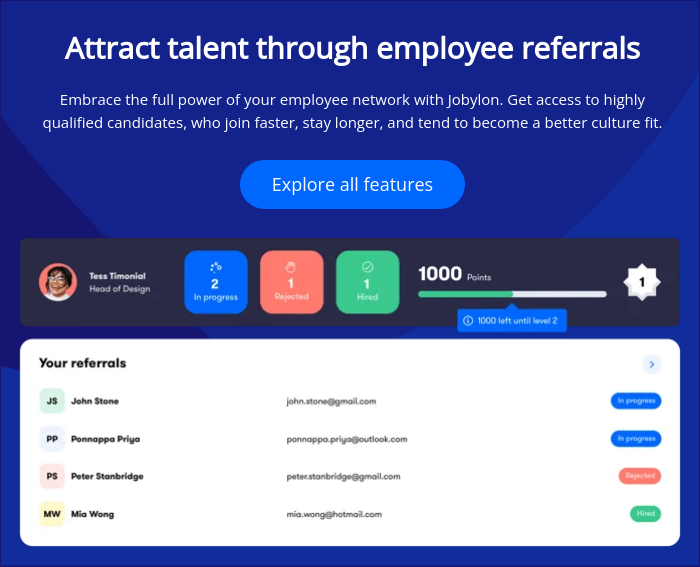Employee referral programs are a popular and effective method for companies to attract top talent while boosting employee engagement and retention. By leveraging their existing workforce, companies can tap into a pool of high-quality candidates who are likely to be a good fit for the company culture. In this article, we'll explore the benefits of employee referral programs and offer tips for implementing a successful program.

What is an Employee Referral Program?
An employee referral program is a recruitment strategy that involves encouraging current employees to refer qualified candidates for job openings within their organization. The program typically involves offering incentives or rewards to employees who successfully refer a candidate that is ultimately hired by the organization.
Employee referral programs leverage the personal and professional networks of current employees to find potential candidates, which can result in higher quality hires and a faster recruitment process. Overall, employee referral programs can be a valuable tool for organizations to attract top talent and create a more engaged workforce.
What are the benefits of employee referral programs?
Employee referral programs benefit companies by attracting top talent, increasing employee engagement and retention, and tapping into personal and professional networks. Referrals tend to result in higher quality hires and already have a connection to the company culture. Incentives for successful referrals increase employee motivation and satisfaction, as they feel valued and recognized. Employee referral programs are a win-win for both employers and employees, building strong teams and driving business growth.
Attract top talent: Employee referral programs enable companies to expand their reach beyond traditional activities and attract top talent who may not be actively searching for a new job but could be open to a new opportunity.
Increase employee engagement and retention: By involving employees in the recruitment process, companies can increase employee engagement and retention, as employees feel more invested in the success of the company and are more likely to stay long-term.
Tap into personal and professional networks: Employee referrals allow companies to tap into the personal and professional networks of their employees, which can help identify potential candidates who are a good fit for the company culture.
Result in higher quality hires: Referrals tend to result in higher quality hires, as they are often pre-screened by the referring employee and already have a connection to the company culture.
Pre-screen potential candidates: Referring employees can pre-screen potential candidates, saving time and resources for the company by narrowing down the candidate pool to only those who are likely to be a good fit.
Build strong teams and drive business growth: Overall, employee referral programs can help build strong teams and drive business growth, by attracting top talent, increasing employee engagement and retention, and ultimately contributing to the success of the company.
Strategies for employee referral program
1. Establish clear goals and expectations
Before launching an employee referral program, it's important to establish clear goals and expectations. This includes defining which types of positions are eligible for referrals, the rewards employees will receive for successful referrals, and how the program will be tracked and measured. Setting achievable goals can help keep employees motivated to participate and make the program more successful overall.
2. An Automated Employee Referral Program
An automated employee referral program is a structured approach to managing the referral applications by automating and digitizing the touchpoints of a referral journey. It includes the automated programming of all stages in referral recruiting, from streamlining daily administrative tasks of managing employee referrals and the communication process, tracking the applicants' progress throughout the referral touchpoints, to monitoring when a reward is due and the referrer entitled to receive it.
An assisted handling of employee referrals will rejuvenate your referral procedures and allow you to shorten the time and cut costs of administrative efforts associated with the manual management. There won't be any more small talks, endless phone calls and emails, lost referral applications, never ending excel lists, additional tasks and administrative efforts around rewarding. With Jobylons recruitment platform you can integrate Radancy to make your employee referral program automated!
3. Reward employees
The goal for any successful employee referral program is to reach a high employee engagement rate within the referral activities. Showing appreciation and recognition to your Talent Scouts for their commitment to extra tasks plays a central role in starting and keeping providing referrals. Accordingly, gratifying incentive policies and an entertaining and engaging reward system will prompt employee engagement within your employee referral program.
So, what are the main components of the winning reward strategy and how do you select the right amount of cash bonuses and the most attractive non-monetary incentives? There is no secret ingredient as every company has different organizational setups and, therefore, requirements and demands. However, the main difference between monetary and non-monetary incentives is that monetary rewards are usually paid in a cash bonus when the referred candidate gets hired. The payment of cash bonuses usually occurs after the probationary period, even if our referral experts advise splitting the amount into two stages of payment so that the Talent Scouts' satisfaction is doubled.
4. Motivated Talents Scouts
Talent Scouts are the main actors of employee referral programs: employee referrals' sustainability and active usage depend entirely on them. However, rewards and referral incentives are not the only motivation drivers to keep engaged with the referral activities by regularly providing you with new referrals.
Company culture plays a crucial role in employee engagement. Satisfied employees are more demanding with their employers: they require their workplaces to align with their personal perspectives and objectives. It reflects in fair compensation, flexibility to work from home, growth opportunities and health benefits, and getting recognition for work commitment and support by receptive leaders to pursue career advancement and achieve personal goals.
Moreover, employees also expect employers to guarantee a diverse, equitable and inclusive working environment. And this is also confirmed by the prospective candidates: 38% would turn down a job offer if the company lacked diversity in its workforce or had no clear goals for improving diversity. Therefore, if employers want to retain their current workforce and attract the top quality job seekers, they have to offer these workplace conditions.
5. Scalable Growth Strategy
The best imprint you can give to your employee referral program is designing the referral strategy that includes evolving over time to accommodate your future growth needs. Securing that the referral software of your choice is well-fitted and equipped with the proper functions is a strategic move to consolidate a smart usage of your referral data.
Good traceability of referral data is indeed crucial as it allows you to reshape your previously set criteria and rethink the KPI of your employee referral program. This way, you can adjust and adapt with data at hand to your employee referral program as it gradually takes off and the referral journey develops.
6. Provide training or resource
Some employees may be unsure of how to refer candidates or what types of candidates the company is looking for. Providing training or resources, such as guidelines or FAQs, can help improve the quality and quantity of referrals. This can also help to reduce the burden on HR or recruitment teams, who may otherwise need to spend time explaining the referral process to employees.
7. Evaluate the success
Evaluating an employee referral program is an essential step in ensuring its success. Regular evaluation can help identify areas for improvement and ensure that the program is meeting its goals. It can include:
- Tracking the number of referrals received
- Quality of referrals
- The number of hires made through referrals
- The retention rate of referred employees
Employers can also gather feedback from employees to gain insights into the effectiveness of the program and make adjustments as necessary. By using this information to refine the program over time, employers can improve its effectiveness and ensure that it continues to attract top talent to the organization. Ultimately, evaluating the program helps to ensure that it remains a valuable tool for both the organization and its employees.
Do you need help with your employee referral program? Book a demo and we can talk more about it!
Last updated:
